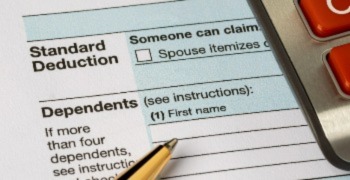
What is communication service tax and which companies have to pay it?
It’s 5:00 p.m. on a Tuesday. After wrapping up your last Zoom meeting of the workday, you close your laptop and focus on dinner. Your kids beg for pizza so you order a large pepperoni pie using a mobile phone app then track delivery via the restaurant’s text messages. After eating, you change into your workout clothes and practice yoga in front of your fitness mirror, following along with your favorite instructor. Finally, you wind down the day by gathering with your family in the living room to call Grandma on her old-school landline.
Most of us don’t think about how many communications tools we interact with daily. Yet, they’re a major part of our lives. The sheer volume of communications products and services available to consumers is impressive and new technologies are continuously being developed.
While we talk a lot about the dizzying pace of evolution in the communications industry, today we’re getting back to basics. We’re zeroing in on types of companies that make up the communications sector. The products and services they sell run the gamut. But one factor they share in common is that, with few exceptions, they’re subject to complex communications taxes.
What is communication service tax?
There’s no single communication service tax. The term communications tax refers to a multitude of taxes, fees, and surcharges assessed at the federal, state, and local levels. In addition, many businesses that are subject to communications tax must also pay sales and use tax on their products and services. The wide variety of rates, rules, and regulations across jurisdictions makes communications tax compliance especially difficult and some states are trickier than others.
Here are some of the types of businesses that are likely to be on the hook:
The legacy lives on: Traditional telecoms
There’s a reason you’ve heard of these businesses. As some of the oldest players in the telecom industry, they’ve been around the block and still dominate.
Traditional telecoms often bundle broadband internet, voice, and cable TV services as a “triple play” suite.
Examples include AT&T, Comcast (which delivers Xfinity-branded services), and Charter Communications (which offers services branded as Spectrum).
State and local jurisdictions depend heavily on these businesses for tax dollars. Because traditional telecoms have been around for so long, most jurisdictions have statutes that regulate the services they sell. That’s not always the case with newer technologies. In addition, traditional telecoms tend to be subject to the most complex telecommunications tax and sales tax laws.
The rise of wireless carriers: Mobile phones and fixed wireless internet access
More than 5.2 billion people in the world and 85% of adults in the United States own smartphones. Many of us carry our phones everywhere we go and couldn’t imagine living without them.
The largest wireless phone carriers in the U.S. are Verizon, AT&T, and T-Mobile. These well-known brands own their own networks.
But most mobile carriers in the U.S. are mobile virtual network operators (MVNOs) that piggyback off a major carrier’s network of cell towers. Mint Mobile and Consumer Cellular are two examples.
Wireless phone carriers are increasingly expanding their services to include fixed wireless internet access. Fixed wireless internet uses radio waves to send high-speed internet signals from the carrier’s towers to receivers installed at the consumer’s home or business. This relatively new technology is typically extended to rural areas where fiber-optic lines and cable broadband aren’t available.
Voice is just the start: Voice over Internet Protocol and Unified Communications as a Service providers
We’re lumping Voice over Internet Protocol (VoIP) and Unified Communications as a Service (UCaaS) providers together because they share similarities in how they offer communications services.
VoIP allows you to make calls using a broadband internet connection. Much like your favorite ice-cream shop, VoIP comes in a variety of flavors. There’s static VoIP, which allows calls to be made and received at one place, and nomadic VoIP, which allows calls to originate from or terminate at any location. Non-interconnected VoIP, sometimes called peer-to-peer VoIP, allows you to contact other users operating the same VoIP software, such as an online game system. These different VoIP flavors can complicate communications tax and regulatory fees.
UCaaS providers streamline voice, video, and messaging in one cloud-based centralized platform. Vonage and RingCentral are two examples.
Which UCaaS features are taxable and how they should be taxed is a matter of debate. Some argue that calls routed to voicemail or a recorded message should be taxed like an information service, whereas those calls answered by a person should be subject to the same taxes as phone calls. This gets confusing because small businesses sometimes use UCaaS services to create the impression that they have a traditional phone tree when, in fact, calls are delivered to a server so they can then be forwarded to other phone systems.
Streaming takes over: The swelling streaming industry
Streaming platforms like Netflix, Hulu, and Disney+ are pushing cable TV aside as more consumers cut the cord. Streaming viewership exceeded cable TV for the first time in July 2022, and continues to
remain the top programming choice as of February 2023.
Fewer cable subscribers means less revenue for state and local tax authorities, which are struggling to come up with new ways to tax streaming. Their tactics range from expanding the definition of pay TV to filing lawsuits that claim streaming services should be subject to cable franchise fees because they depend on the use of other companies’ internet infrastructure.
Now that streaming companies are rolling out ad-supported free and reduced-cost plans, jurisdictions stand to lose even more unless they find an avenue for taxing the ads.
Entertainment isn’t the only streaming content available to consumers. Some fitness equipment manufacturers like Peloton incorporate streaming subscriptions into their products. When you attend classes online to earn a certification or watch a recording of a wellness video, that’s also considered streaming. In some states, digital subscriptions and paid services such as these are subject to communications tax or sales tax.
Making connections: The Internet of Things (IoT)
From refrigerators to pacemakers to trackers that spot engine faults in buses, the last few years have seen explosive growth in smart objects of all kinds for consumers and businesses. An estimated 27 billion Internet of Things (IoT) devices will exist by 2025. IoT is both transforming our lives and complicating communications tax for the companies that manufacture such products.
Whether an IoT device is taxable generally depends more on the “I” than the “T.” Specifically, how a device connects to the internet matters.
Taxing internet access hasn’t been allowed since Congress approved the Internet Tax Freedom Act (ITFA) of 1998. ITFA placed a temporary moratorium on state and local taxes that was repeatedly extended until lawmakers finally approved the Permanent Internet Tax Freedom Act (PITFA) in 2015.
A smart fridge that reminds you to buy milk, for example, is hooked up to your cell phone using a private internet connection in your home or business. Chances are you use your internet connection for more than just operating your fridge. Your home Wi-Fi network most likely falls under the ITFA so there’s no tax on the data.
But consider an intelligent electronic device used to control and automate a remote power substation. Because the device doesn’t access the internet beyond transmitting data through it, there are significant questions about whether a dedicated data connection supplied for the device meets the definitions of internet service. If not internet service, then it would most likely be in the much more taxable WAN/LAN communications category. A lack of enforcement clarity makes these questions all the more challenging and the stakes substantial.
It’s all in the mix: Managed service providers (MSPs)
Managed service providers (MSPs) deliver a range of IT services to businesses, from help desk support to network infrastructure management and cybersecurity. There are tens of thousands of MSPs in the United States, including many small companies, and their services are in high demand.
Communications tax can be tricky for MSPs because they often offer a variety of services in diverse categories. For example, they may provide Wi-Fi, voice service for a call center, and cloud storage. Each of these services could be subject to separate communications tax rates and rules that vary across state and local jurisdictions.
Many MSPs resell UCaaS solutions. Bundling services like voice, videoconferencing, and SMS is a common practice but opens up another can of worms. In some states, including just one taxable item can make an entire bundle subject to communications tax.
In it together: Communications Platform as a Service (CPaaS) and Software as a Service (SaaS)
Communications Platform as a Service (CPaaS) companies like Twilio and Bandwidth are taking the business world by storm. A whopping 95% of global enterprises will adopt API-enabled CPaaS solutions by 2025, according to Gartner.
Businesses use CPaaS in many different ways to improve customer engagement, enhance collaboration, and increase productivity. Many companies use CPaaS to send automated SMS and voice notifications to customers such as appointment reminders and delivery updates. Others use CPaaS to deliver videoconferencing and wireless connectivity.
B2B SaaS businesses use CPaaS to add voice calling and video chat to their CRM and marketing automation platforms. They also use CPaaS to provide customers with more ways to interact with their products and to create the communications services they charge for.
Communications tax becomes particularly complicated for both CPaaS providers and SaaS companies that implement their APIs when all of these technologies are rolled up into one platform. Each service may be taxed differently and it can be hard to keep track of rates and rules in all the jurisdictions where you do business.
Heading up support: Telco connectivity and infrastructure
If the telecom industry were a skeletal system, this category would make up its backbone. From wires to rooms, these are the businesses that support connectivity and make up infrastructure.
First, we have fiber providers, also known as fiber-optic network operators, whose networks transmit data, voice, and video signals at high speeds to businesses and consumers. According to the Fiber Broadband Association, 68 million homes in the U.S. have access to fiber internet. Fiber providers range from large traditional telecom companies to smaller regional providers.
In remote and rural areas where fiber and cable don’t reach, satellite services are bringing people online. Wireless phone providers and manufacturers are partnering with providers like Starlink and Globalstar to allow customers to send messages from dead zones. Thanks to satellite-powered Wi-Fi on airplanes, you can now check your social media accounts or surf the web during flights. As satellite services become within reach for more consumers, we’ll continue to see them used in new ways.
Colocation facilities provide rental space, power, and bandwidth for servers and other computing hardware. They’re often liable for communications taxes on the telecommunications services they use, such as internet connectivity and phone lines. In addition, they may be required to collect and remit taxes on behalf of their business customers.
IT teams at many businesses rely on software-defined networking (SDN) to make their networks more flexible and easier to manage. Cloud-based SDN solutions allow enterprises to move their network infrastructure to the cloud, making it easier to scale. Providers often sell these services on a subscription basis.
The reality is that organizations deploying SDN solutions and vendors who sell these services may be subject to a jumble of different communications tax rates and regulations.
One type of SDN service that’s seen explosive growth in recent years is software-defined wide area network, or SD-WAN technology. SD-WAN is used to connect distributed offices, data centers, and customers across wide distances. Tax authorities and regulatory agencies may take a closer look at SD-WAN and we could see potential enforcement in this area.
Did your business make the list?
If you see yourself in this story now, or you plan to use any of these technologies in your products or services in the future, consider whether you have all the tools you need to stay compliant.
Avalara for Communications is a complete communications tax and sales tax solution. Talk with our communications tax compliance experts to better understand how automation can help you meet your obligations.
When the weekend rolls around, you’ll be able to gather your family, stream a favorite movie, and relax knowing your business is prepared for what lies ahead.

The Avalara Tax Changes midyear update is here
Trusted by professionals, this valuable resource simplifies complex topics with clarity and insight.
Stay up to date
Sign up for our free newsletter and stay up to date with the latest tax news.














